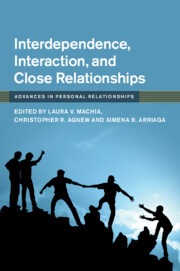Book contents
- Interdependence, Interaction, and Close Relationships
- Advances in Personal Relationships
- Interdependence, Interaction, and Close Relationships
- Copyright page
- Contents
- Figures
- Tables
- Contributors
- Acknowledgments
- Introduction
- Part I Interdependence, Situations, and Context
- Part II Interdependence, Security, and Risk
- 5 An Interdependence Analysis of Enhancing Attachment Security
- 6 Safe and Secure
- 7 Partner Buffering in Interdependent Relationships
- 8 Stress as a Risk Factor to Well-Being
- Part III Interdependence, Goal Pursuit, and Person Factors
- Part IV Interdependence, Timing, and Expectations
- Index
- References
8 - Stress as a Risk Factor to Well-Being
Role of Dyadic Coping
from Part II - Interdependence, Security, and Risk
Published online by Cambridge University Press: 19 June 2020
- Interdependence, Interaction, and Close Relationships
- Advances in Personal Relationships
- Interdependence, Interaction, and Close Relationships
- Copyright page
- Contents
- Figures
- Tables
- Contributors
- Acknowledgments
- Introduction
- Part I Interdependence, Situations, and Context
- Part II Interdependence, Security, and Risk
- 5 An Interdependence Analysis of Enhancing Attachment Security
- 6 Safe and Secure
- 7 Partner Buffering in Interdependent Relationships
- 8 Stress as a Risk Factor to Well-Being
- Part III Interdependence, Goal Pursuit, and Person Factors
- Part IV Interdependence, Timing, and Expectations
- Index
- References
Summary
Relational partners are considered to be interdependent, such that their experiences are linked to one another. Based on principles of interdependence, it can be argued that partners’ experiences of stress and coping are also shared. The systemic transactional model posits that one partner’s experience of stress can affect the other partner by direct (“I’m stressed!”) or indirect (e.g., shutting down) stress expression (stress crossover). Furthermore, the ability to cope with such stressors also relies on both partner’s individual and joint coping resources. Grounded in interdependence theory, the goal of this chapter is to present an overview of how stress and coping can be understood as an interdependent construct. To highlight this, we present research on the negative associations between stress and individual and relational well-being, and the ways in which couples can cope with stress based on their shared experiences by engaging in dyadic coping. Given the robust literature on the well-established associations between stress and dyadic coping, this chapter presents recent research that extends applications of the systemic transactional model to unique populations: same-sex couples coping with minority stress and heterosexual couples coping with stress associated with the transition to parenthood.
Keywords
- Type
- Chapter
- Information
- Interdependence, Interaction, and Close Relationships , pp. 160 - 180Publisher: Cambridge University PressPrint publication year: 2020

